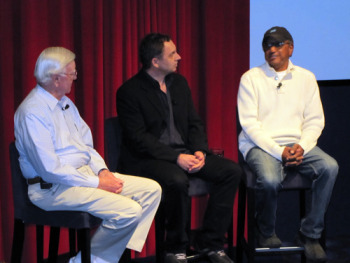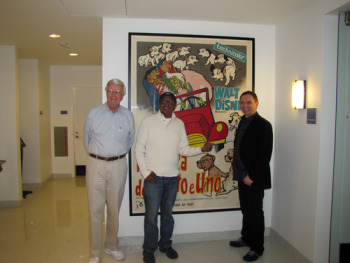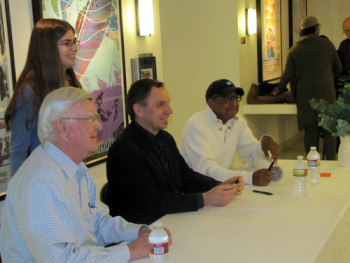Spots…Spots…Spots!
How did the Disney Animators draw thousands of spots in Walt Disney’s 101 Dalmatians and how did they make sure they always remained in the correct…spot? Disney Legends Don Iwerks and Floyd Norman, and legendary Disney Animator Andreas Deja provided the answers to these questions, and shared many fascinating behind-the-scenes stories about the production of the animated film to guests attending The Walt Disney Family Museum's The Art and Process of 101 Dalmatians event.
 Andreas and Floyd shared rarely seen concept art and story sketches, as they discussed some of the key players in the creation of the film. Guests were treated to character development drawings and sketches by Milt Kahl, Ollie Johnston, Bill Peet, Ken Anderson, and Marc Davis. The audience saw how closely the storyboard sketches resembled the final film, and learned that Bill Peet storyboarded the entire film himself. They also learned that Marc Davis drew every scene of Cruella De Vil in the film without the help of assistant animators.
Andreas and Floyd shared rarely seen concept art and story sketches, as they discussed some of the key players in the creation of the film. Guests were treated to character development drawings and sketches by Milt Kahl, Ollie Johnston, Bill Peet, Ken Anderson, and Marc Davis. The audience saw how closely the storyboard sketches resembled the final film, and learned that Bill Peet storyboarded the entire film himself. They also learned that Marc Davis drew every scene of Cruella De Vil in the film without the help of assistant animators.
Before moving over to WED Imagineering, Disney Legend Rolly Crump worked on the “Spots” team. This group of assistant animators was responsible for keeping the spots in the same place from scene to scene. They accomplished this difficult task by creating a “key spot” and making sure that the surrounding spots always followed the key spot. Don, Floyd, and Andreas all agreed that 101 Dalmatians would not have been possible without the creation of the Xerox© process.
 Roy Disney was concerned with the rising cost of creating an animated feature film. Floyd recalled how the film Sleeping Beauty had been extremely labor intensive and comprised of a crew of six hundred and took five years to complete.
Roy Disney was concerned with the rising cost of creating an animated feature film. Floyd recalled how the film Sleeping Beauty had been extremely labor intensive and comprised of a crew of six hundred and took five years to complete.
Don Iwerks told the story of Roy having lunch with his father, Ub Iwerks, one afternoon. Roy explained that the Studio could no longer afford to create the thing they were built on, traditional animated films. Roy asked Ub if he could think of any way to bring down the cost of producing that animation. Ub analyzed the animation production process and realized that he could streamline the ink and paint processes.
With Roy's permission, Ub purchased a new desktop copier from Xerox and tested copying ink onto cells. He secretly created a test film using the copied cells and screened it privately for Walt. Afterwards, Ub explained to Walt that the test film he had just seen had been Xeroxed, not hand inked. Walt knew that Roy had been looking for cost-saving measures and gave Ub the go ahead by saying, “Why don’t you look into it.” Ub worked with Xerox engineers to expand the desktop machine into a process that spanned three rooms. Don explained this Xerox process to the Museum guests in detail, using schematics and photos of the actual Xerox process rooms at the Walt Disney Studios.
 While the Disney Animators were extremely pleased with the new sketchy look of 101 Dalmatians, Walt was not. This was the first time the Animators had seen their own lines up on the big screen. They felt like there was no drop in the quality of the drawings, because previously their lines had been traced and inked several times before the final images were filmed. Walt was shocked by the sketchy look of 101 Dalmatians. He felt like his Animators went from the beautiful painting-like perfection ofSleeping Beauty to a rough sketchbook look in 101 Dalmatians.
While the Disney Animators were extremely pleased with the new sketchy look of 101 Dalmatians, Walt was not. This was the first time the Animators had seen their own lines up on the big screen. They felt like there was no drop in the quality of the drawings, because previously their lines had been traced and inked several times before the final images were filmed. Walt was shocked by the sketchy look of 101 Dalmatians. He felt like his Animators went from the beautiful painting-like perfection ofSleeping Beauty to a rough sketchbook look in 101 Dalmatians.
Diane Disney Miller commented, “Dad told Ken Anderson that he set animation back with the sketchy look, but never complained about the film at home. He just had to get used to it.” In the end, the Xerox process not only helped to save the Animation Department at the Walt Disney Studios but it also became the industry standard for other smaller animation studios.

Joseph Titizian
Volunteer at The Walt Disney Family Museum
